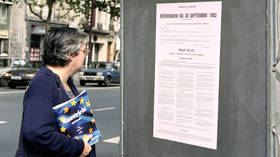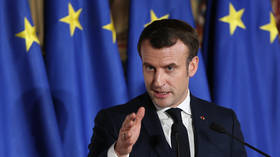Maastricht Treaty 30 years on: Has EU been a success?

Those behind the European project understood that they had to keep their true intentions hidden from the public. Although they always knew that the final destination was a United States of Europe, they were politically savvy enough to know that the people of Europe would not wear it.
That’s why throughout the 1960s, 70s, and 80s, European federalists disguised their thirst for political integration in the small print of lots of economic agreements. Of course, the heads of states and politicians who signed these agreements were aware that they were only a stepping-stone to political integration, but they too were in on the plan and kept their voters in the dark.
Things all changed thirty years ago today, when the European federalists had what I call their ‘Wizard of Oz moment.’ On February 7, 1992, the Maastricht Treaty was signed, which drew back the curtain and revealed to the public the true intentions of the European elites.
The Maastricht Treaty was signed by twelve states, including Germany, France, Italy, Ireland, and the UK, and it created the European Union. From that moment, the project ceased to be an economic community, which was always somewhat of a ruse, and instead revealed itself as an unashamed political entity. Indeed, no longer did moves towards political integration have to be disguised as vague economic agreements, and from now on it was full-turbo Euro federalism.
So, what did this seminal treaty actually do? Well, first it made clear that “every person holding the nationality of a Member State shall be a citizen of the Union.” Therefore, those of us who resided in a member state now had parallel citizenship. We were no longer just German, British, French, or Italian, we were also citizens of the European Union, whether we liked it or not.
In effect, it meant that those of us who lived within this new glorious European Union could travel and work wherever we wanted in any member state. After all, we were now a part of one large European-wide happy family. This, as I will explain, came back in years to come to haunt the Eurocrats, and in ways they did not expect.
The treaty officially moved the member states towards monetary union, with a commitment to create the Euro currency. So, gone forever would be the Franc, the Deutschmark, the Italian Lira, the Peseta, and they hoped one day, the British Pound. Instead, in their places, there would be a Europe-wide currency controlled by the European Central Bank (ECB) in Frankfurt, Germany.
But the treaty did not stop there and, in some ways, one has to respect the naked ambition contained in it, as well as the hubris. Maastricht for example, gave “broader authority, including formal control of community policies on development, education, public health, and consumer protection and an increased role in environmental protection, social and economic cohesion, and technological research.”
Moreover, the Maastricht Treaty gave the European Court of Justice (ECJ) the power to fine member states for non-compliance with EU rules and regulations. We are witnessing that being played out at the moment with the battle over EU rule of law in Poland, Hungary, and Romania.
Maastricht represented the largest and most profound transfer of power from sovereign states to a supranational organisation, without it coming through invasion or the use of military force. However, the problem the Eurocrats faced was that the treaty’s ratification required referendums in some countries, and unsurprisingly, they found the public were divided.
The treaty was not positively received in EU member states. The French, for example, only narrowly supported the ratification of the treaty in a referendum, with 51% voting in favour 49% against. The Danes voted No to the ratification of the treaty by a similarly close margin. Although the Danes were asked to vote again in 1993 and ratified the treaty, albeit with opt-outs, the message was clear: not all the peoples of Europe were invested in where the EU was headed.
The treaty also led to political uproar in the UK. John Major’s Conservative government, which backed the UK signing the treaty, only managed to hang on by the skin of its teeth. Moreover, the decision of the government to support the document led to the creation of UKIP, and therefore Maastricht was the first step on the long road to Brexit, some 24 years later.
Has the EU since Maastricht been a success? In one sense the answer has to be yes, as the union has accrued ever more competences from member states, and it has continued to expand. But this is where it all began to unravel.
The Maastricht Treaty was signed by western European states, all with relatively similar economies. Therefore, the movement of peoples between member states was reasonable, and, on the whole, unnoticeable. However, when the EU chose to expand further eastwards in the early 2000s, and incorporated poorer economies, people began to drift westwards in droves, looking for work.
Suddenly wages, particularly in blue-collar jobs, began to depreciate and working-class people began to notice that their communities were changing at breakneck speed in front of their eyes. Governments were powerless to stop it happening because the people who were coming were European citizens under the provisions of Maastricht, and its updated versions. And here is where the backlash began and why Eurosceptic movements across western Europe began to grow.
Indeed, this is one of the principal reasons the UK voted to leave the EU in 2016. It is therefore easy to make the argument that if there was no Maastricht Treaty, there would have been no Brexit.
Today marks the thirtieth anniversary of the creation of the EU. What we find is an organisation struggling to be relevant on the international stage. Dreams of a fully federal Europe contained in the Maastricht Treaty may well still burn brightly in Berlin and Paris, but less so in Budapest and Warsaw. The UK has already walked out of the club and others may well follow its lead. I hope I am still around to write a piece to celebrate the fiftieth anniversary of the Maastricht Treaty because I think we will find that the EU will look very different, if it exists at all.
The statements, views and opinions expressed in this column are solely those of the author and do not necessarily represent those of RT.















